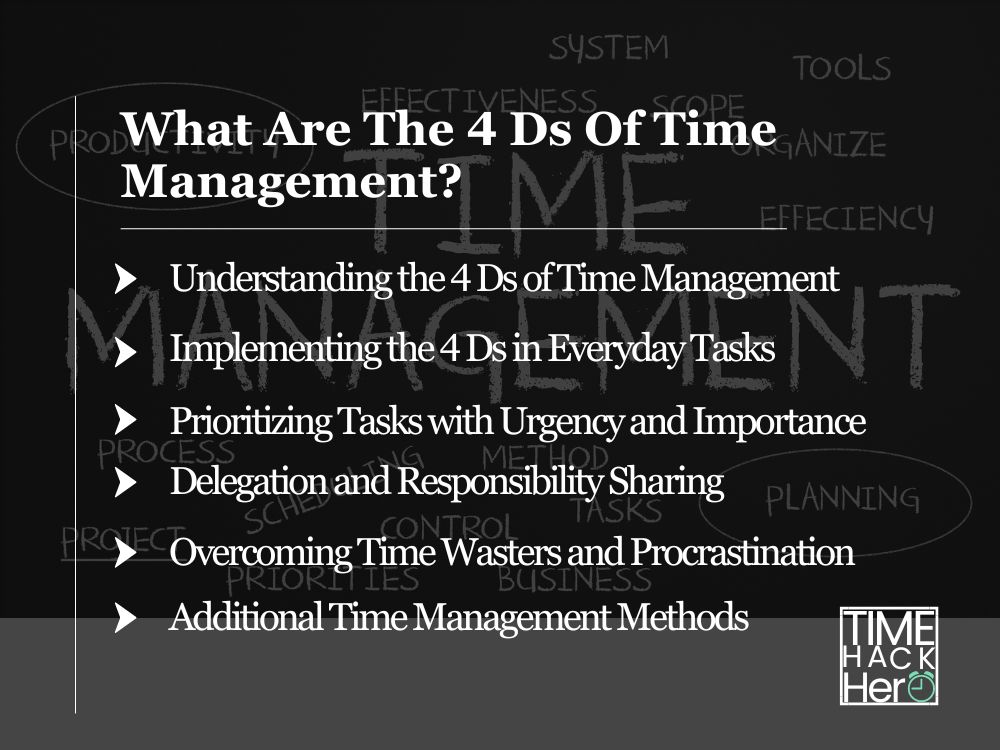Time management is a vital skill that everyone should possess to enhance productivity and achieve a work-life balance. One widely recognized time management strategy is the 4 Ds of Time Management, which serves as a practical filter for prioritizing and handling tasks efficiently.
The 4 Ds of Time Management encompass Delete, Delegate, Defer, and Do. By applying these principles, individuals can sift through their tasks to determine which need immediate attention and which can be allocated to a later time, delegated to others, or dropped altogether. By mastering the 4 Ds, one can enhance their productivity and optimize their schedule for improved overall time management skills.
Being well-versed in the 4 Ds can greatly benefit project managers who have to handle numerous requests from various sources. Using this method offers valuable guidance in decision-making and streamlines their work processes, leading to more comprehensive management of resources and time.
Table of Contents
Understanding the 4 Ds of Time Management
The 4 Ds of Time Management is a helpful method for prioritizing tasks and managing time effectively. This technique is based on the Eisenhower Matrix, which was created to evaluate the importance and urgency of tasks. The 4 Ds stand for: “Do”, “Delegate”, “Defer”, and “Drop”. Applying these four categories to your tasks can aid in achieving productive time management and streamlining your workload.
Do
“Do” refers to tasks that are both important and urgent. These tasks should be addressed immediately, as they are crucial to meeting goals and deadlines. Examples of “Do” tasks include:
- Attending client meetings
- Completing urgent reports
- Addressing critical issues
It is important to prioritize these tasks and complete them as soon as possible to avoid stress and potential repercussions.
Delegate
“Delegate” tasks are important, but not urgent. These tasks can be assigned to someone else, allowing you to focus on more pressing matters. Delegation is an essential skill for leaders and can help distribute work more evenly among team members. Proper delegation involves:
- Identifying the right person for the task
- Clearly communicating expectations and deadlines
- Providing necessary resources and support
When delegating effectively, you can ensure that important tasks are completed while freeing up time for urgent matters.
Defer
“Defer” tasks are not immediately important, but still need to be addressed in the future. These tasks can be postponed or scheduled for later completion. To effectively defer tasks, consider:
- Scheduling a specific date and time to tackle the task
- Creating a reminder or adding it to a to-do list
- Reevaluating its importance periodically
Deferred tasks should be revisited when there is a lull in urgent or important tasks, ensuring they eventually receive attention.
Drop
“Drop” tasks are neither important nor urgent. These tasks can be eliminated from your workflow, as they do not contribute to your overall productivity or goals. Identifying and dropping tasks may involve:
- Evaluating its relevance to your objectives
- Weighing the task’s value against the time and resources it requires
- Assessing if the task can be automated or streamlined
Dropping tasks can lead to a more efficient workflow and allow you to dedicate time and energy to more important assignments.
Implementing the 4 Ds in Everyday Tasks
Handling Emails
Product managers often receive a large volume of emails and prioritizing them is crucial. The 4 Ds can help manage the email inbox:
- Delete: Discard unimportant or irrelevant messages immediately.
- Delegate: Forward emails to relevant team members if they are better suited to handle them.
- Defer: If an email requires attention, but not immediately, set a reminder and schedule time to respond.
- Do: Respond to essential emails promptly to avoid delays and ensure efficient communication.
Managing Meetings
Time management during meetings is crucial to ensure decisions are made effectively and within the allotted hours of the meeting. The 4 Ds can help streamline meetings:
- Delete: Remove unnecessary meetings from your schedule or shorten the duration if possible.
- Delegate: Assign a team member to attend routine or low-priority meetings on your behalf.
- Defer: Reschedule non-urgent meetings for times when workloads are lighter.
- Do: Actively participate in and facilitate decision-making during high-priority meetings.
Organizing To-Do Lists
Creating an organized and prioritized to-do list is central to efficient time management. Implement the 4 Ds while forming your list:
- Delete: Eliminate low priority or irrelevant tasks.
- Delegate: Assign tasks to team members who have the expertise and capacity to complete them.
- Defer: Schedule non-urgent tasks for later, dedicating time when you can focus on them.
- Do: Tackle high-priority tasks immediately and allocate sufficient time and resources.
By integrating the 4 Ds in everyday tasks, product managers can enhance their decision-making and prioritization, leading to better efficiency and time management.
Prioritizing Tasks with Urgency and Importance
Urgency-Importance Matrix
The Urgency-Importance Matrix, also known as the Eisenhower Box, is an effective method to prioritize tasks based on their urgency and importance. It comprises four quadrants:
| Quadrant 1 | Quadrant 2 |
|---|---|
| Urgent and Important | Not Urgent but Important |
| Quadrant 3 | Quadrant 4 |
|---|---|
| Urgent but not Important | Not Urgent and not Important |
Identifying Priorities
To prioritize tasks, follow these steps:
- List all tasks that need to be completed.
- Determine the urgency and importance of each task.
- Assign each task to the appropriate quadrant in the Eisenhower Box.
- Plan actions for each quadrant:
- Quadrant 1: Complete these tasks first.
- Quadrant 2: Schedule these tasks into your calendar.
- Quadrant 3: Delegate these tasks if possible.
- Quadrant 4: Limit or eliminate these tasks.
Setting Goals
Incorporating goals into your time management process can help guide your prioritization:
- Short-term goals: Focus on urgent tasks, such as meeting immediate deadlines.
- Mid-term goals: Balance urgent tasks with the important tasks that contribute to your long-term goals, like personal development or long-term projects.
- Long-term goals: Work on important tasks that may not have immediate deadlines but are crucial for your growth and success.
Remember to avoid procrastination, especially for Quadrant 2 tasks, as they are important for achieving your goals and well-being. Continuously reassess your priorities and adjust your actions to stay aligned with your goals.
Delegation and Responsibility Sharing
Effective Delegation
Effective delegation is a skill that can greatly improve time management and collaboration in project management. It involves assigning tasks and responsibilities to others in a way that maximizes their skills and abilities, while also ensuring that the overall goals of the project are met.
- Identify the strengths and weaknesses of team members
- Clearly communicate expectations and deadlines
- Provide necessary resources and support
- Trust your team members to complete their tasks
- Monitor progress and be available for guidance
Benefits of Delegation
Delegating tasks not only helps with time management but also comes with several benefits for both the manager and team members:
- Increased productivity: By assigning tasks to individuals with the right skills, tasks can be completed more efficiently.
- Better team morale: Team members feel more empowered and motivated when they are trusted with responsibilities.
- Opportunities for growth: Delegation allows team members to learn new skills and gain experience in areas they might not have otherwise been exposed to.
- Distributing workload: Proper delegation helps manage workload and prevents burnout among team members.
Collaboration and Communication
Collaboration and communication are essential aspects of responsibility sharing in project management. To ensure successful delegation and effective teamwork, project managers should focus on the following:
- Encourage open communication: Team members should feel comfortable sharing ideas, concerns, and progress updates.
- Set clear goals and expectations: Outline the project goals and individual responsibilities to reduce confusion and miscommunication.
- Foster a collaborative environment: Encourage team members to work together, share knowledge, and support one another in achieving project objectives.
- Utilize communication tools: Use project management and communication tools to streamline workflows and ensure all team members have access to relevant information.
By focusing on effective delegation, reaping the benefits of delegation, and prioritizing collaboration and communication, project managers can create a positive and efficient work environment while managing time effectively.
Overcoming Time Wasters and Procrastination
Time Thieves
Recognizing time thieves, events or activities that drain your productive time, is an essential step in avoiding procrastination. Some common time thieves include:
- Social media
- Unnecessary meetings
- Repeatedly checking email
- Lengthy conversations
To combat these time thieves, implement time management techniques like the 4 Ds:
- Do: Act on important tasks immediately.
- Delete: Ignore irrelevant tasks.
- Defer: Delay tasks that can be done at a later time.
- Delegate: Assign tasks to others when possible.
Multitasking vs. Focus
The concept of multitasking often seems appealing, but it can actually lead to burnout and reduced productivity. Instead of trying to do multiple tasks at once, focus on one task at a time until it’s completed. This helps minimize errors and maximizes your efficiency.
One technique to improve focus is the Pomodoro Technique, which breaks work into short intervals (usually 25 minutes) with short breaks in between. This helps maintain concentration and prevents burnout.
Reducing Distractions
Eliminating distractions is key to successful time management. Here are some suggestions:
- Create a dedicated workspace: Ensure your environment is organized and free from distractions.
- Turn off notifications: Silence your phone and disable email alerts during your focused work time to minimize disruptions.
- Set boundaries: Communicate your work hours and availability to others around you.
- Take breaks: Regular breaks help your mind recharge, making you more focused and productive.
By addressing time thieves, improving focus, and reducing distractions, you’ll be well-equipped to overcome time wasters and procrastination.
Additional Time Management Methods
In addition to the 4 Ds of Time Management, there are other methods and techniques that can help you manage your time more effectively. In this section, we’ll discuss three such methods: the Inbox Zero Method, the Eisenhower Matrix, and Goal Setting and Tracking.
Inbox Zero Method
Inbox Zero is a popular time management technique that aims to keep your email inbox empty or nearly empty at all times. The idea is to quickly process and organize emails as they come in, rather than letting them pile up and cause stress. Here are the steps to achieve Inbox Zero:
- Process your inbox at set intervals, usually two or three times a day.
- Quickly scan each email to determine its importance.
- Immediately delete or archive unimportant messages.
- If the email requires action, follow the 4 Ds: Delete, Delegate, Defer or Do.
- Organize important emails into folders or labels for easy retrieval.
By following these steps, you can keep your inbox under control and minimize the time spent on email management.
Eisenhower Matrix
The Eisenhower Matrix is a powerful tool for making decisions about how to allocate time and prioritize tasks. The matrix divides tasks into four quadrants based on their urgency and importance:
| Important | Not Important | |
|---|---|---|
| Urgent | Quadrant 1 | Quadrant 3 |
| Not Urgent | Quadrant 2 | Quadrant 4 |
- Quadrant 1: Important and urgent tasks that require immediate attention.
- Quadrant 2: Important but not urgent tasks that should be scheduled and completed.
- Quadrant 3: Urgent but not important tasks that can either be delegated or postponed.
- Quadrant 4: Not important and not urgent tasks that should be eliminated or reduced.
By using the Eisenhower Matrix, you can prioritize tasks by weighing their urgency and importance, helping you focus on what truly matters.
Goal Setting and Tracking
Another crucial component of good time management is setting clear goals and tracking progress toward them. To effectively set and track goals, follow these steps:
- Define your goals using the SMART criteria: Specific, Measurable, Achievable, Relevant, and Time-bound.
- Break down larger goals into smaller, manageable milestones.
- Use a time tracking tool, like Timetrack or Toggl, to monitor your progress and time spent on tasks.
- Regularly review your goals and make adjustments as necessary to stay on track.
By setting clear goals and actively tracking your progress, you can maintain focus and ensure that you’re using your time effectively.









